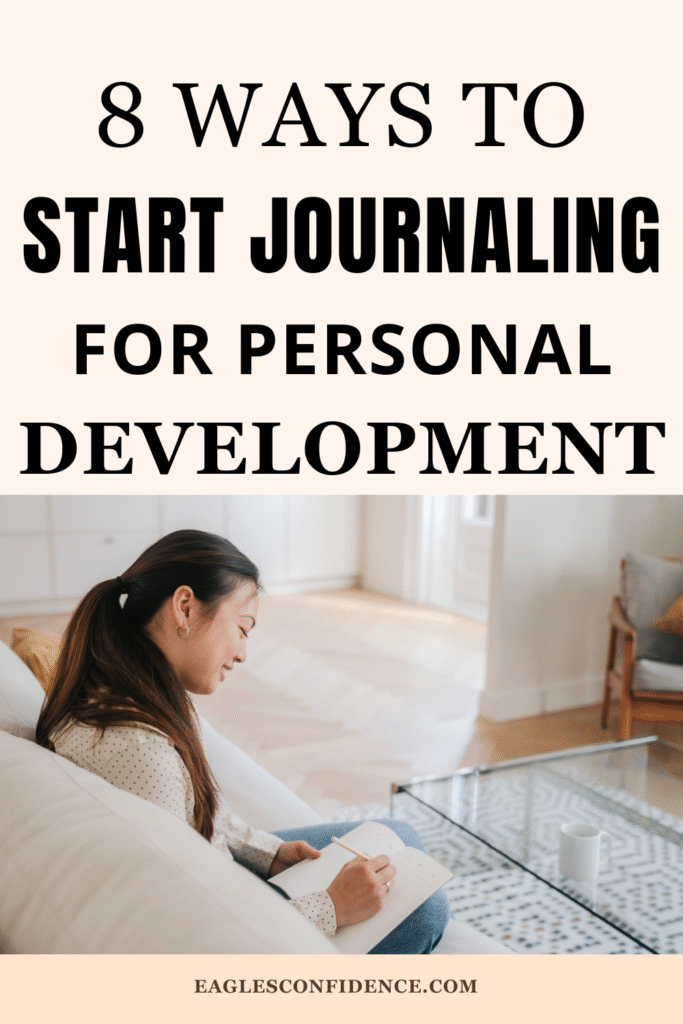Journaling is this super flexible thing we use to figure ourselves out, like a way to untangle our feelings, plan our lives, and just generally grow as people. It’s like having a chat with yourself on paper, which turns out to be pretty helpful.
Seriously, writing things down helps you make sense of your messy emotions, figure out what you want, and keep track of your progress. It’s like a brain dump that makes you feel better and more organized. Plus, it helps you get to know yourself better, understand what you care about, and build up your confidence. So, grabbing a notebook and starting to write can lead to some pretty cool changes in your life.
How To Start Journaling For Self Development
1. Choose the Right Type of Journal
Picking the right kind of journal is key to getting the most out of your self-development journey. There are a bunch of different types, each with its vibe and purpose. If you’re looking to boost your positive vibes, a gratitude journal is awesome for noting down all the good stuff in your life. For those who like to be organized and creative, bullet journals let you plan and doodle your way to your goals. And if you’re curious about your dreams and their meaning, a dream journal can help you decode those nightly adventures.
Then there’s the free-writing journal, which is a blank canvas for your brain to spill its thoughts without any rules. It’s super freeing and can help you uncover some hidden gems about yourself. Ultimately, the best journal is the one you enjoy using and that fits what you’re trying to achieve. So, take a peek at the different styles and find one that makes you excited to write, and you’ll be well on your way to some serious self-growth.
2. Set a Regular Journaling Schedule
To get the most out of journaling, you need to make it a regular thing. Figure out when you have a few minutes each day – maybe first thing in the morning or just before bed – and stick to it. Setting alarms on your phone or tying it to something you already do, like your morning coffee, can help you remember. Make sure you’ve got a nice, quiet spot where you can write without distractions, and make it cozy with things that make you feel good.
It takes a bit of time to get into the swing of things, but being consistent is key. The more you write, the easier it gets, and you’ll start to see some real changes in how you think and feel. This regular self-reflection isn’t just about what you write down; it’s about how it makes you feel in your day-to-day life, helping you grow and understand yourself better.

3. Write Prompts to Get Started
If you’re ready to dive into journaling for self-growth, try using some prompts to get you started. Think about writing about a life-changing moment and how it shaped you, or list qualities you admire in others and how you can adopt them. You can also explore your feelings by writing about a recent emotional experience and plan your future by picturing where you want to be in five years. And don’t forget to tackle any obstacles you’re facing by writing about what’s holding you back and brainstorming solutions.
These prompts are like little nudges to help you dig deeper into your thoughts and feelings. By writing about these things, you’ll start to understand yourself better and figure out how to grow. Your journal becomes a safe space to explore, plan, and work through challenges, making it a powerful tool for personal development.
Related: 8 Ways To Stop Procrastinating And Get More Down
4. Incorporate Mindfulness Techniques
To make your journaling impactful, try adding some mindfulness to the mix. Start by taking a few deep breaths before you write, just to get yourself centered and present. When you’re writing, try to observe your thoughts and feelings without judging them. Just let them flow onto the page, and pay attention to how the pen feels, how you’re breathing, and what’s going on around you. This helps you tune into what’s happening inside.
You can also try doing a quick body scan or visualization before you start writing. Checking in with your body or picturing a peaceful place can help you relax and get ready for some deep thinking. Combining these mindfulness tricks with your journaling makes it a much richer experience, helping you connect with your thoughts and grow as a person.
5. Express Emotions Through Writing
Journaling is an effective way to deal with tough emotions. Instead of letting those feelings bottle up and cause stress, writing them down helps you work through them. It’s like having a conversation with yourself on paper, which can make things feel clearer and less overwhelming. You can release all those pent-up feelings, spot patterns in how you react, and create a safe space to explore sensitive topics without worrying about what anyone else thinks.
But it’s not just about the hard stuff. Journaling also lets you celebrate your wins, which is super important for building confidence. By writing down your successes, big or small, you remind yourself of your strengths and how far you’ve come. This can give you a real boost and keep you motivated. Journaling is an active way to take care of your emotional health, helping you understand yourself better and grow.
6. Review and Reflect on Your Journal Entries
To get the most out of journaling, you need to go back and read your old entries every so often. This lets you see the bigger picture of your thoughts and feelings and spot any patterns that keep popping up. Set aside some time each week or month to do this, and as you read, notice how you’ve changed. Ask yourself questions like, “What challenges keep showing up?” or “What am I proud of?” This helps you understand your emotional journey and where you’re headed.
Try to look at your journal entries like a story of your life, not like a collection of judgments. This way, you can appreciate how far you’ve come and still see where you need to grow. Write down any insights you get right after your review, and compare your past thoughts with your current ones. This helps you track your progress and keeps you motivated. Reviewing your journal helps you see yourself more clearly and keeps you moving forward on your self-development journey.

7. Create a Safe and Inspiring Environment
Creating the perfect spot for journaling is key to getting the most out of it. Start by finding a quiet place where you won’t be bothered, whether it’s a cozy corner inside or a peaceful spot outside. Make sure you’ve got comfy seating and good lighting, and maybe add some calming colors to the room. Think about how the space feels and how it makes you feel.
Then, personalize it! Add things that inspire you, like art, photos, or quotes. You could also use aromatherapy or soothing sounds to make the space even more relaxing. And keep all your journaling stuff organized and easy to reach. When your journaling space feels just right, it becomes a little sanctuary where you can dive into your thoughts and grow.
Related: How To Develop And Trust Your Intuition In 8 Ways
8. Stay Committed to Your Journaling Journey
Sticking with journaling can be tough, especially when you hit writer’s block or feel like you’ve got nothing to say. To get past this, make journaling a regular thing, like an appointment with yourself. Don’t wait for inspiration; just set aside time each day or week to write. Also, start small. Instead of trying to write pages of deep thoughts, just jot down a few bullet points or short entries. It’s about exploring your thoughts, not writing perfectly.
To keep yourself motivated, celebrate your progress! Look back at your old entries to see how far you’ve come, and reward yourself when you hit journaling milestones. These little celebrations can help you build a lasting habit. By making journaling a regular part of your life and dealing with the challenges along the way, you’ll find it’s a powerful tool for your personal growth.
Types Of Journaling
1. Gratitude Journaling
Gratitude journaling involves regularly noting down what you are thankful for. This type of journaling has been scientifically shown to boost happiness levels and reduce stress. By focusing on positive aspects in life, individuals can cultivate a mindset that encourages optimism and contentment. Just a few minutes dedicated to gratitude can significantly influence one’s overall mood and perspective on life.
2. Bullet Journaling
Bullet journaling blends creativity with organization. It is a customizable method for tracking tasks, events, and goals. Utilizing symbols and short entries allows users to quickly visualize their priorities. This adaptive approach not only increases productivity but also makes the journaling process enjoyable and engaging. Bullet journaling encourages individuals to tailor their journals to fit their personal needs and styles.

3. Dream Journaling
Dream journaling is the practice of recording dreams upon waking. This type of journaling can aid in understanding subconscious thoughts and can unveil insights about emotions or life situations. By documenting dreams, individuals can uncover recurring themes or symbols, promoting deeper self-reflection and emotional exploration. Through the process, dream journaling may serve as a source of inspiration and creativity.
4. Reflective Journaling
Reflective journaling involves thoughtfully considering one’s experiences and feelings. This type encourages deep introspection, enabling individuals to analyze their thoughts and understand their reactions to various situations. By regularly engaging in reflective journaling, one can identify patterns in behavior and secure a clearer vision of personal development.
5. Art Journaling
Art journaling combines artistic expression with written reflection. This engaging process allows individuals to explore their creativity while documenting their emotional landscape, using various media such as drawing, painting, and collage. The fusion of images and words in art journaling nurtures a unique narrative that reflects the creator’s inner thoughts and emotions.
6. Travel Journaling
Travel journaling is a delightful way to capture experiences from journeys, allowing travelers to reflect on their adventures. This type of journaling often includes sketches, photographs, and personal anecdotes. By documenting their travels in a journal, individuals can preserve memories and reflect on the lessons learned while exploring new cultures and landscapes.
7. Goal Journaling
Goal journaling focuses on setting and tracking personal objectives. By writing down aspirations and breaking them into actionable steps, individuals create a roadmap for success. This structured approach encourages accountability and motivation, making it easier to stay committed to one’s goals.
Save the pin for later
